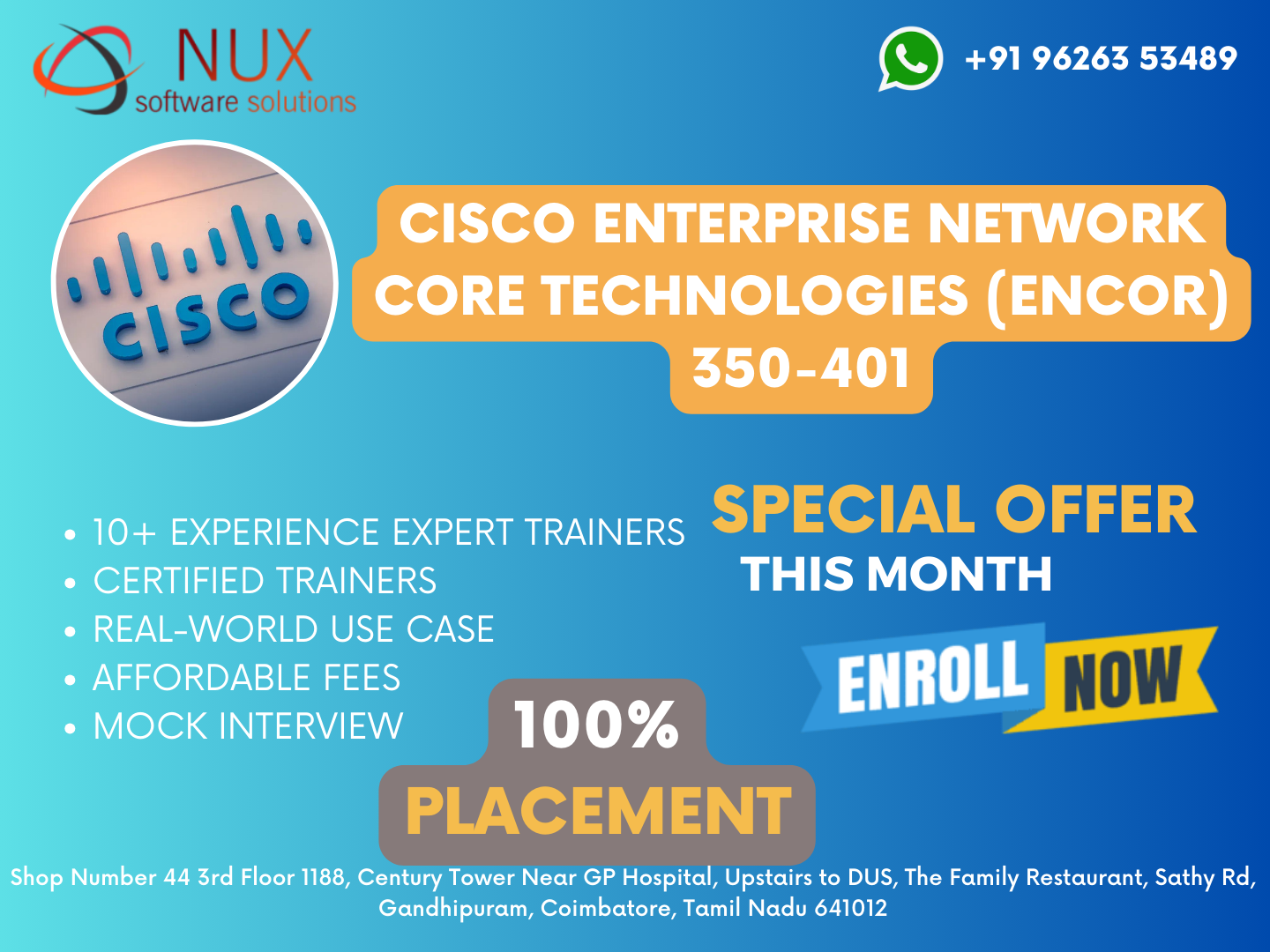Cisco Certified Design Expert (CCDE)


Cisco Certified Design Expert (CCDE) Training Institute In Coimbatore: Best Cisco Certified Design Expert (CCDE) training courses classes deliver by Nux software solutions in coimbatore.
Nux software solutions in coimbatore has excellent and advanced training programs that will give you better performance & hands on experience. Our industry’s expert trainers offer a wide range of skills and experience in their graded areas. The Training center environment is too good for professional, individual, corporate, live project training and industrial training. Labs infrastructure is advanced, well managed and you can access LAB 24X7 from anywhere.
Training center has international expert trainers and they have excellent knowledge, real time industry experience. Our Training programs combine with several innovative learning methods and delivery models. We understand your requirement and it will give you 100 percent growth for your career and provide the cost effective training programs and also work with flexibility for the trainees.
Moreover, we have designed a lab having the well-equipped infrastructure and 24/7 accessible facility that is ideal even for professionals, corporate, individuals, live project training, industrial training as well.
We have placed above 500 registered companies and 10000+ students and professionals, all are working in the reputed positions.
Course Syllabus
Module 1
Describe fast convergence techniques and mechanisms, a) Down detection, b) Interface dampening
Chapter 2
Describe loop detection and mitigation protocols, a) Spanning tree types, b) Spanning tree tuning technique
Chapter 3
Describe mechanisms that are available for creating loop-free topologies, a) REP, b) Multipath, c) Switch clustering, d) Flex links e) Loop detection and mitigation
Chapter 4
Describe the effect of transport mechanisms and their interaction with routing protocols over different types of links
Chapter 5
Describe multicast routing concepts
Chapter 6
Describe the effect of fault isolation and resiliency on network design, a) Fault isolation, b) Fate sharing, c) Redundancy, d) Virtualization, e) Segmentation
Module 2 - Layer 3 Control Plane
Describe route aggregation concepts and techniques, a) Purpose of route aggregation, b) When to leak routes / avoid suboptimal routing, c) Determine aggregation location and techniques
Chapter 2
Describe the theory and application of network topology layering, a) Layers and their purposes in various environments
Chapter 3
Describe the theory and application of network topology abstraction, a) Purpose of link state topology summarization, b) Use of link state topology summarization
Chapter 4
Describe the effect of fault isolation and resiliency on network design or network reliability, a) Fault isolation, b) Fate sharing c) Redundancy
Chapter 5
Describe metric-based traffic flow and modification, a) Metrics to modify traffic flow, b) Third-party next hop
Chapter 6
Describe fast convergence techniques and mechanisms, a) Protocol timers, b) Loop-free alternates
Chapter 7
Describe factors affecting convergence, a) Recursion, b) Microloops, c) Transport
Chapter 8
Describe unicast routing protocol operation [OSPF, EIGRP, ISIS, BGP, and RIP] in relation to network design, a) Neighbor relationships, b) Loop-free paths, c) Flooding domains and stubs, d) iBGP scalability
Chapter 9
Analyze operational costs and complexity, a) Routing policy, b) Redistribution methods
Chapter 10
Describe the interaction between routing protocols and topologies
Chapter 11
Describe generic routing and addressing concepts, a) Policy-based routing, b) NAT, c) Subnetting, d) RIB-FIB relationships
Chapter 12
Describe multicast routing concepts, a) General multicast concepts, b) Source specific, c) MSDP/anycast, d) PIM, e) mVPN
Chapter 13
Describe IPv6 concepts and operation, a) General IPv6 concepts, b) IPv6 security, c) IPv6 transition techniques
Module 3 - Network Virtualization
Describe Layer 2 and Layer 3 tunnelling technologies, a) Tunnelling for security, b) Tunnelling for network extension, c) Tunnelling for resiliency, d) Tunnelling for protocol integration, e) Tunnelling for traffic optimization
Chapter 2
Analyze the implementation of tunnelling, a) Tunnelling technology selection, b) Tunnelling endpoint selection, c) Tunnelling parameter optimization of end-user applications, d) Effects of tunnelling on routing, e) Routing protocol selection and tuning for tunnels
Module 4 - Design Considerations
Analyze various QoS performance metrics, a) Application requirements, b) Performance metrics
Chapter 2
Describe types of QoS techniques, a) Classification and marking, b) Shaping, c) Policing, d) Queuing
Chapter 3
Identify QoS strategies based on customer requirements, a) DiffServ, b) IntServ
Chapter 4
Identify network management requirements
Chapter 5
Identify network application reporting requirements
Chapter 6
Describe technologies, tools, and protocols that are used for network management
Chapter 7
Describe the reference models and processes that are used in network management, such as FCAPS, ITIL®, and TOGAF
Chapter 8
Describe best practices for protecting network infrastructure, a) Secure administrative access, b) Control plane protection
Chapter 9
Describe best practices for protecting network services, a) Deep packet inspection, b) Data plane protection
Chapter 10
Describe tools and technologies for identity management
Chapter 11
Describe tools and technologies for IEEE 802.11 wireless deployment
Chapter 12
Describe tools and technologies for optical deployment
Chapter 13
Describe tools and technologies for SAN fabric deployment
Module 5 - Evolving Technologies v1.1
a) Compare and contrast public, private, hybrid, and multicloud design considerations
[i] Infrastructure, platform, and software as a service (XaaS) [ii] Performance, scalability, and high availability [iii] Security implications, compliance, and policy [iv] Workload migration
b) Describe cloud infrastructure and operations
[i] Compute virtualization (containers and virtual machines) [ii] Connectivity (virtual switches, SD-WAN and SD-Access) [iii] Virtualization functions (NFVi, VNF, and L4/L6) [iv] Automation and orchestration tools (CloudCenter, Cisco DNA-center, and Kubernetes)
Chapter 2 Network programmability (SDN)
a) Describe architectural and operational considerations for a programmable network
[i] Data models and structures (YANG, JSON and XML) [ii] Controller based network design (policy driven configuration and northbound/ southbound APIs) [iii] Configuration management tools (agent and agentless) and version control systems (Git and SVN) [iv] Device programmability (gRPC, NETCONF and RESTCONF)
Chapter 3 Internet of things (IoT)
a) Describe architectural framework and deployment considerations for IoT
[i] IoT technology stack (IoT Network Hierarchy, data acquisition and flow) [ii] IoT standards and protocols (characteristics within IT and OT environment) [iii] IoT security (network segmentation, device profiling, and secure remote)


